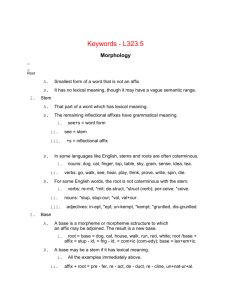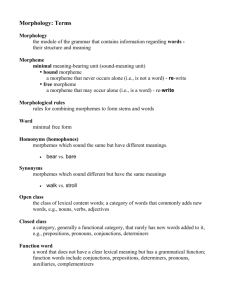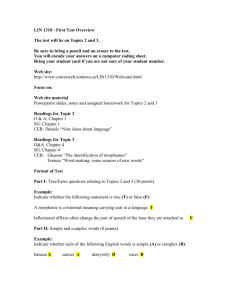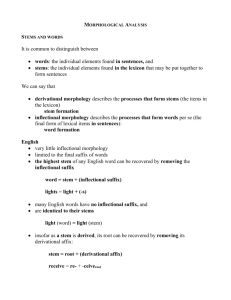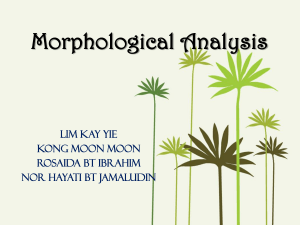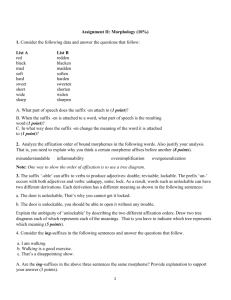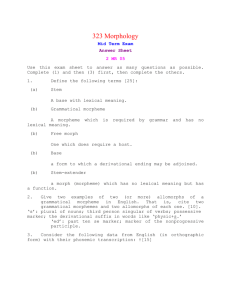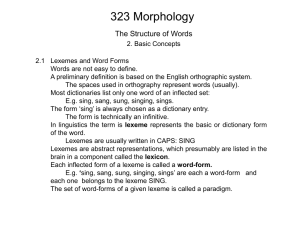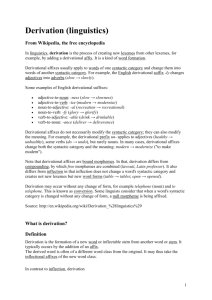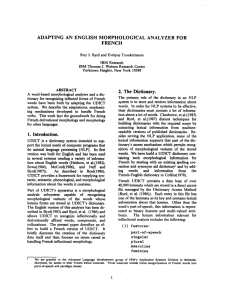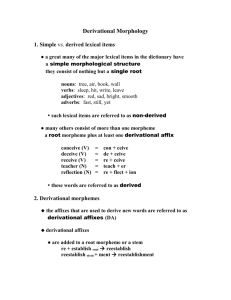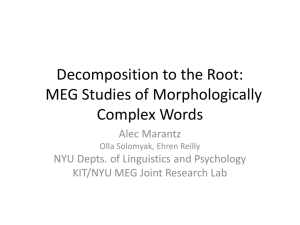323-MT-F06
advertisement
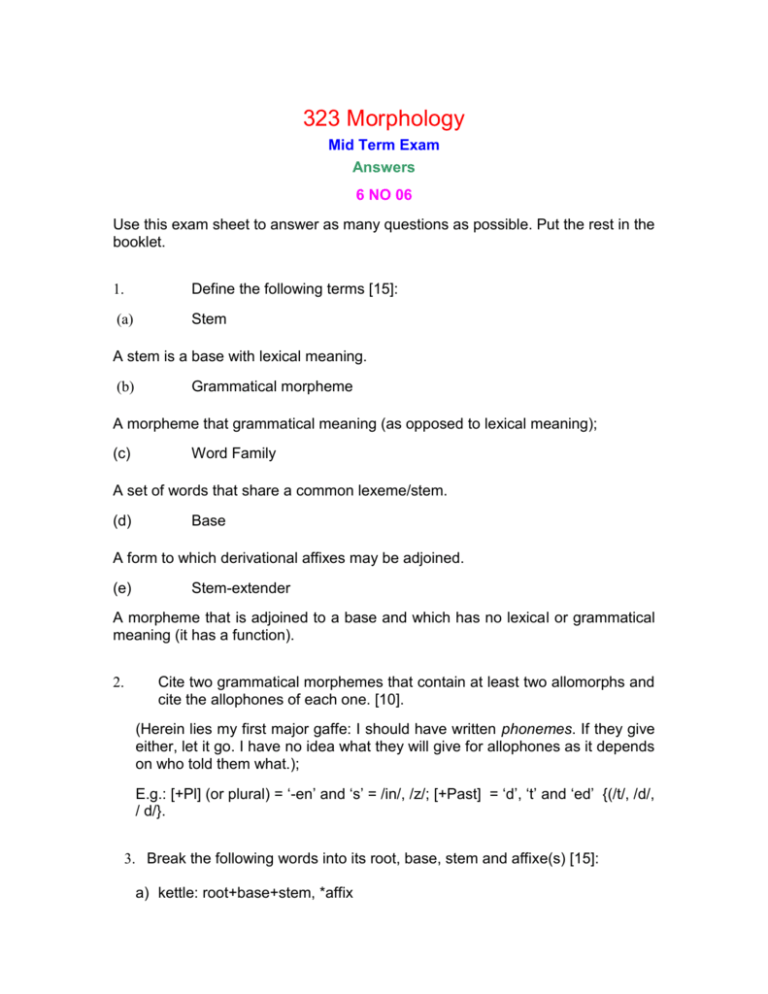
323 Morphology
Mid Term Exam
Answers
6 NO 06
Use this exam sheet to answer as many questions as possible. Put the rest in the
booklet.
1.
Define the following terms [15]:
(a)
Stem
A stem is a base with lexical meaning.
(b)
Grammatical morpheme
A morpheme that grammatical meaning (as opposed to lexical meaning);
(c)
Word Family
A set of words that share a common lexeme/stem.
(d)
Base
A form to which derivational affixes may be adjoined.
(e)
Stem-extender
A morpheme that is adjoined to a base and which has no lexical or grammatical
meaning (it has a function).
Cite two grammatical morphemes that contain at least two allomorphs and
cite the allophones of each one. [10].
2.
(Herein lies my first major gaffe: I should have written phonemes. If they give
either, let it go. I have no idea what they will give for allophones as it depends
on who told them what.);
E.g.: [+Pl] (or plural) = ‘-en’ and ‘s’ = /in/, /z/; [+Past] = ‘d’, ‘t’ and ‘ed’ {(/t/, /d/,
/ d/}.
3. Break the following words into its root, base, stem and affixe(s) [15]:
a) kettle: root+base+stem, *affix
b) hopefully: hope: root+base+stem; ful = affix; ly = affix. (hope-ful = stem)
and( hope+ful+ly = stem)
c) mandate = mand+ate: mand = root+base, *stem; ate = affix.
d) demand (V). = de+mand: mand = root+base, * stem; de = affix.
4. What the three goals of a (linguistic) theory? [5]
Briefly, describe one of them.
1. observational adequacy
2. descriptive adequacy
3. explanatory adequacy.
5. Determine the morpheme-based lexical form for the following words (as far
as we know) [10]:
a) button (noun)
BUTTON
Function
N
Form
Sign
/b√tn/
b) gallop (verb)
GALLOP
Function
V
Form
Sign
/gæl´p/
c) puny
PUNY
Function
A
Form
/pjúni/
Sign
6. Determine the word-form information for the following word: [10]
a) bottom (noun)
‘bottom’
Function
N
Form
/batm/
Sign
b) desire (verb)
‘desire’
Function
V
Form
/dizájr/
Sign
c) giddy.
‘giddy
A
Function
Form
/gIdi/
Sign
7. Are the following English affixes inflectional or derivational? Each of these
affixes has more than one function—determine their function. Find a
minimum of two functions per form. (2 extra points if you can find a third
function). The function may vary between inflection and derivation. [20]
“-ed”, “-s”, “-er”.
a)
-ed is inflectional with two functions: [+Past], [+Passive], [+Perfect]
(relevance).
-ed is derivational with at least one function: six-legged, twoheaded.
b)
-s is inflectional with two functions: [3PS] on verbs, [+Plural] on
nouns.
-s is derivational forming nouns: the pits (Sg.), the heaves ( (Sg.),
the willies; linguistics, physics, mathematics, classics.
c)
-er is inflectional on adjectives and adverbs [+Comparative]
-er is derivational: worker, writer, talker; cooker, toaster, sharpener,
eraser.
Write the appropriate grammemical (i.e. like lexical) entries for “-ed”.
Function is the key word here — if a morpheme has more than one function,
treat it as two or more grammemes.
[+Past]
[+Suffix], [V-host]
/d/
[+Pl]
[+Suffix], [N-host]
/d/
Agent, N
[+Suffix], [V-host]
/r/
8. What is/are the difference(s) between a morpheme based grammar and a
word-form based grammar? Select a word of your choice, but not one in
either question 4 or 5 above. Discuss your answer in terms of a morphemebased lexical entry and a word-form entry. [15]
HOUSE
N
/hæws/
‘house’
N
/hæws/
A morpheme-based grammar recognizes morphemes, the smallest units in
morphological theory. Word-based grammars do not recognize morphemes.
The word-form is at the bottom of the pile. In the upper figure, HOUSE
represents a stem (a lexeme) but in the lower figure ‘house’ is a word-form
that is singular. Lexemes occur without inflectional endings. ‘house’ is
considered an inflected form. The form and the sign are the same here.
